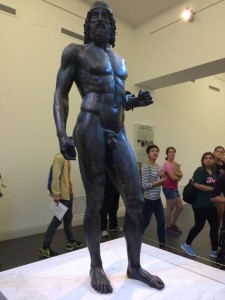

The Famous Riace Bronzes (My pic exhibits Statue A at the left from the Museo Archaeologico Nazionale Reggio Calabria, and a general pic exhibiting both statues (A, then B) is to the right).
Ciao again, ragazzi. Just posting twice today since I didn’t post yesterday (it’s once per day on the trip, right?). I thought I might change it up a little since I didn’t have anything more to say about Palermo, and show you one of my fave artifacts that we saw on our trip when my abroad program went south from Rome to Reggio Calabria before we made the ferry trip across to Sicily this past October. We saw both statues exhibited at the archaeological museum there, along with other ancient Greek and Roman artifacts dredged from the sea. These guys are known as the fabled Riace Bronzes, and have a curious history. Two things that many scholars agree on is that 1), the wonderful workmanship of both of these bronze sculptures is evident and 2) these sculptures were discovered off the coast of Riace, Italy, which is where their name comes from. The rest, however, is famously controversial. The statues themselves are referred to as Statue A and Statue B, as their real names have’t been conclusively agreed upon. Some scholars do think they might represent works from a bigger collection, and these statues may potentially represent characters from the play Seven Against Thebes, However, these dates are also not a sure bet: some scholars also tend to think that they could be replications and thus newer, perhaps dated to some time after 100 BC. The scholars who argue for the 5th century BC date are convinced that the sculptures exhibit key features of the Early Classical sculptural methods. A scholar named Caroline Houser also notes that “repairs to Statue B in antiquity” probably “indicate that the sculpture was not new when it was lost at sea” (Houser 5) and argues that the transport of the statues was likely part of the trend of Romans taking Greek statues from sculptures as loot back to Italy. Unfortunately, the boat has never been found, and we may never truly know where it was headed with these statues, or conclusively know much more than we do now about Statues A and B. However, they’ll always hold a place in our hearts (sorry to get soppy, but they are freakin’ amazing statues).
“Riace Warriors.” Khan Academy. Web. 14 Mar. 2016.
Houser, Caroline. “THE RIACE MARINA BRONZE STATUES, CLASSICAL OR CLASSICIZING?”.Source: Notes in the History of Art 1.3 (1982): 5–11. Web.